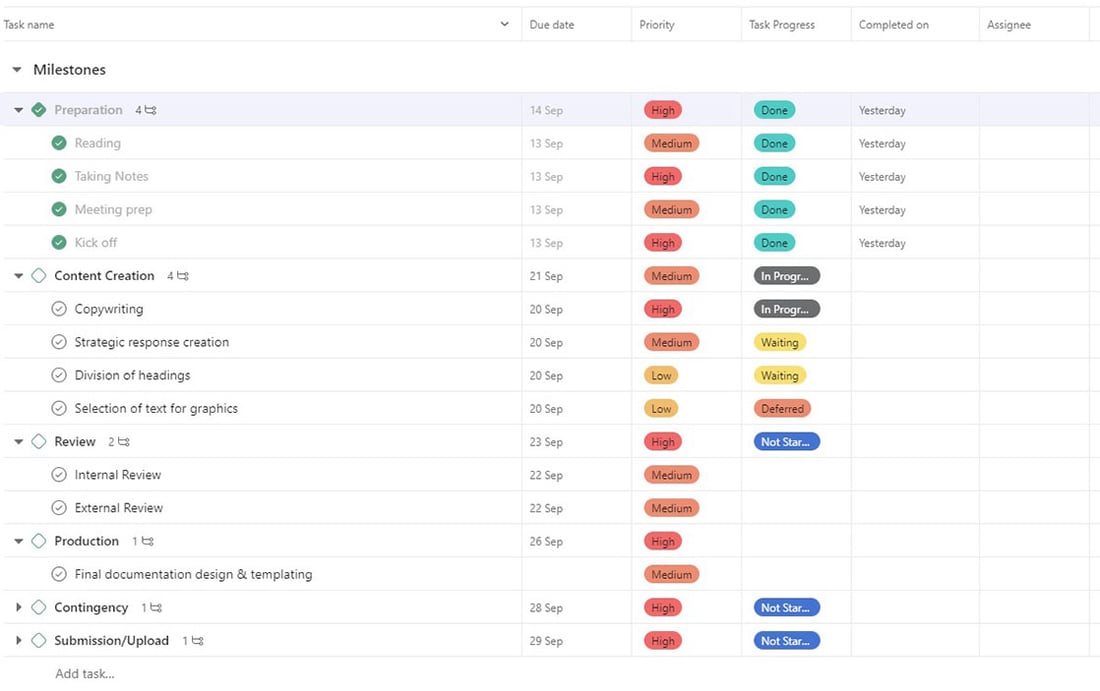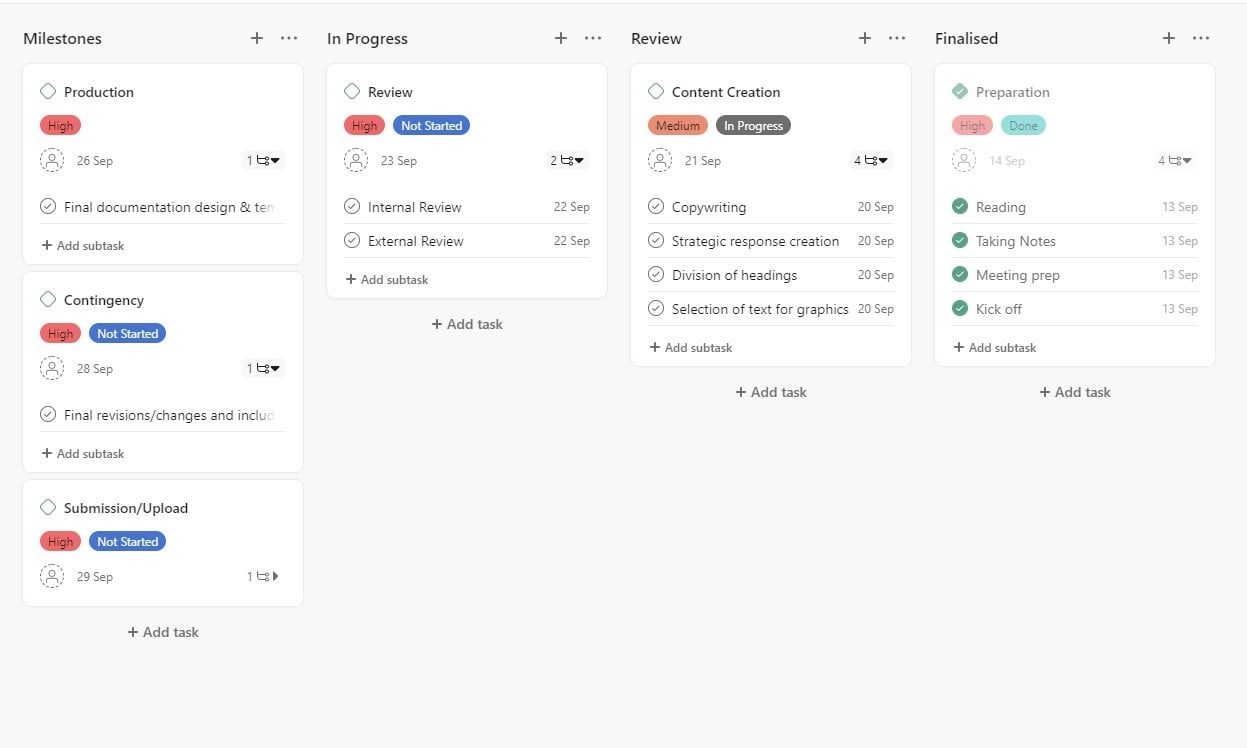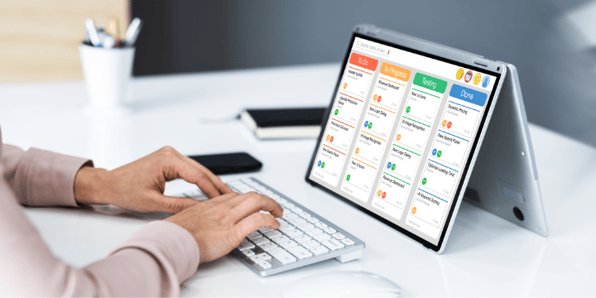 Project management software can revolutionise your tender response process into easy and effective steps. In this article, we’ll discuss the benefits of using technology in conjunction with your tendering process to achieve quality results every time.
Project management software can revolutionise your tender response process into easy and effective steps. In this article, we’ll discuss the benefits of using technology in conjunction with your tendering process to achieve quality results every time.
Having a vision of what needs to be done and when you have the benefit of clear and coordinated steps to create a detailed timeline of the response process. The subsequent management of task allocation is as critical as writing the content of your tender response.
Project management software can revolutionise your tender response process into easy and effective steps. In this article, we’ll discuss the benefits of using technology in conjunction with your tendering process to achieve quality results every time.
Having a vision of what needs to be done and when you have the benefit of clear and coordinated steps to create a detailed timeline of the response process. The subsequent management of task allocation is as critical as writing the content of your tender response.
The Response Process
Let’s think of the tendering process as a project. We first need to split the project into manageable steps (sometimes called milestones) that interact with each other. We have created an effective breakdown of the required steps in the table below.
| Steps/Milestones | Tasks | Approx. % of the time required for responding |
| Preparation | Reading, taking notes, preparing meeting agendas, and kick-off | 10% |
| Content creation | Copywriting, strategic response creation, division of headings and selection of text for graphics | 40% |
| Review | Internal/external reviews | 20% |
| Production | Final document design and templating | 20% |
| Contingency | To minimise potential chaos from final revisions, changes, updates | 10% |
| Submission/upload | Upload/submit completed response with appended files if any | At least 24 hours before the due date. |
It’s evident from the broadly categorised process in the table above that you do not have the entire response period to write content. More than half of your time will be spent in project kick-off, coordination, and management. Now you have the steps to break these down into tasks and sub-tasks that will be needed to deliver your required outcome. By using a project management tool/software to record these steps, tasks and subtasks, you will have ample opportunity to navigate through and effectively complete each step.
Like most aspects in tendering, there is no ‘one-size-fits-all’ solution for project management. To help visualize the various structures and benefits of organizing data see images 1 and 2 below which display milestones and accompanying tasks in both a table view and board format.

Image 1

Image 2
How does project management software help?
The benefits are far and wide. Here’s what a project management software can do for you:
- Create a project and implementation schedule
- Enable time tracking
- Run projects and workflows to your timeline
- Connect teams for efficient collaboration and transparency
- Provide visuals for team management
- Remove manual tasks and automate repetitive processes
- Maintain task allocation and status check
- Serve as a big picture for all your projects
- Offer quality control within workflows
What should you look for when selecting a project management software?
At a minimum, here are six features you can look for when selecting the software you need to manage projects and their tasks.
Collaboration
Features such as real-time notifications, automatic updates, and messaging are collaboration tools that bring the entire team together to work seamlessly on projects.
Scheduling
Modern project management tools can track the time spent on projects. This helps in pre-conceptualisation and feasibility measures for careful planning, organising, and task allocation.
Task allocation
The most apparent feature of project management software is the ability to assign and manage tasks effectively. This aspect within your tender response process is non-negotiable, which means task management will always remain a high priority no matter how complex your project is. Whether tasks are independent or sequential, project management tools can simplify and power how you manage tasks.
Integration
A crucial part of the software is its ability to integrate with other applications. Your team may be using platforms such as HubSpot, OneDrive, Google Drive, Slack, etc. With the number of tools we use in our day-to-day processes, integration becomes essential for data migration and collaboration.
Reporting
Customised reports give you tremendous insight into team performance, project status, action items, and any inefficiencies that need to be addressed. When choosing your project management software, look for ones that generate reports based on the parameters you need to evaluate and improve business processes.
Do’s and Don’ts for choosing your software
- Do research your options for software that offer value and efficiency. You can visit online tutorials or guides that provide easy instructions
- Do create a free account on the tools you shortlist. Explore the features and benefits by testing custom or pre-built templates that suit your project workflow
- Do think about ease of use, scalability and limitations
- Don’t select the cheapest option; make sure you understand the total cost of ownership, which includes support (if you need it)
- Don’t pay for something until you have assessed the functionality and how it can be used to help manage your process
- Don’t undermine the importance of spending the time and effort required to implement and educate staff on usage
Most importantly, it’s helpful to understand your project management pain points so you can understand how the software can assist in overcoming those challenges.
The bottom line
You may have heard of the concept of People, Processes and Tools being the success factors for any business. Remember that the tool you pick is only one element; you need the proper processes that are fully understood and the right skilled people working on the project.
Get started by reading more about these tools:





